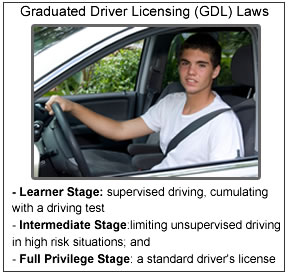Tag Archive: gdl laws

Dramatic Evidence That GDL Laws Work
July 30, 2015
More and more evidence has been coming in over the past few years that GDL (Graduated Driving License) laws work to save lives among teen drivers. Now the State of Connecticut has produced evidence that their GDL law has dramatically reduced the teen death rate in that state.
A report released in May of this year by the Connecticut DMV Center for Teen Safe Driving, credited Connecticut’s strict GDL laws for the fact that, in 2014;
- “For the first time in 12 years, no 16- or 17- year-old passengers died in a crash of a vehicle driven by another 16- or 17- year-old driver in Connecticut.”
- “There was only one death among the 16- or 17- year-old drivers who were governed by the state’s GDL program.”
That’s an incredible accomplishment!
In addition, a report published in 2011 by the Connecticut Children’s Medical Center, stated that Connecticut’s GDL law can be credited with a significant decrease in fatalities among novice teen drivers. It also said that, among the fatal crashes that did occur, half were caused by teen drivers who were in violation of Connecticut’s GDL law.
Prior to 1997, the state didn’t require teens to have a learner’s permit or any specific training requirements before applying for an operator’s license. In 1997, the state passed a law requiring a learner’s permit along with home training for six months or a four month driver’s education program before applying for an operator’s license. However, evidence showed that the new requirements did little to reduce the death rate among teen drivers.
In 2003, the state passed the first GDL laws that set curfew and passenger restrictions for teen drivers. Those laws took effect in 2004. In 2008, after a series of high-profile teen crashes, the state beefed up their GDL laws even more by further strengthening the curfew and passenger restrictions, increasing the requirements for training, and increasing penalties, including the nation’s first 48 hour license suspension for teens charged with any traffic violation. The state also required a two-hour joint parent-teen information session for any 16 or 17 year old applying for a license.
The state vigorously enforced the GDL laws among teen drivers and, ten years after the enactment of the first GDL laws in 2004, the results show:
- A 64 percent reduction in the deaths of 16 and 17 year-old drivers who are governed by the state’s GDL program.
- A 13 percent decline in the number of crashes for the 16 and 17 year-old age group in 2013 compared to the previous two years.
- The Children’s Medical Center report says credits the state’s GDL laws – not maturity, for the dramatic reduction in the teen driver death rate.
The Insurance Institute for Highway Safety lists Connecticut among the top states for effective GDL laws based on the permit age of 16 and the zero teen passenger restrictions.
If other states were to follow this model, the teen driving death rate could be reduced dramatically nationwide. Regardless of what their particular state law says, parents can increase the safety factor for their own teen by setting and enforcing their own strict GDL limits.
Read more: Teen Driver, Passenger Fatalities at Historic Lows, According to New DMV Report Released Today

Have Red Decals Reduced Crashes For Teen Drivers? – It Depends!
July 1, 2015
A newly published study on the use of red decals by teen drivers in New Jersey seems to contradict a study published last year but that depends on the type of license the teen driver holds.
In 2010, New Jersey enacted a law requiring that teen drivers display a red decal in the upper left hand corner of the vehicle license plate. The law was designed to allow law enforcement officers to identify newly licensed teen drivers more easily in order to enforce compliance with the state’s graduated driver license laws (GDL).
Under the New Jersey GDL laws, there are two different permit phases that require a new driver to practice with an accompanying adult driver for at least six months before applying for a probationary license. A teen with a probationary license must drive unsupervised for at least one year and be at least 18 years of age in order to qualify for a basic driver’s license
Under the GDL laws, teen drivers with either a permit or a probationary license:
- must be accompanied by a licensed driver over the age of 21 during the permit phase,
- are prohibited from driving between the hours of 11:01 p.m. and 5:00 a.m.,
- are prohibited from using hand-held or hands-free cell phones or any other electronic devices.,
- are limited to the number of passengers they can carry, and
- must wear seat belts.
The new study published in the journal Injury Prevention attempted to find out if the red decals had any effect on the crash rates of teen drivers during the permit phase. Just like the earlier study, using driver license information and the police reported crash database, they did a comparison of teen crash rates during the four years before the law went into effect with the crash rate in the two years after enactment of the law.
The surprise was that there seemed to be no difference in the crash rate for permitted drivers before or after the law took effect.
The previous study found an overall reduction of 9.5 percent in crash rates for teens after the law went into effect.
So, why the difference? The new study looked strictly at the crash rate for permitted drivers. Drivers with a permit must be accompanied at all times by a supervising driver over the age of 21. Under New Jersey law, if a permitted driver commits a traffic offense, both the teen driver and the supervising driver are held responsible.
The researchers feel that the reason the crash rate for permitted drivers didn’t change was that a permitted driver under the supervision of an adult driver is going to drive more carefully anyway, whether or not a red decal is attached.
The real change to the crash rate was in unsupervised drivers during the probationary license phase. Those probationary drivers experienced a significant drop in crash rates after the requirement for red decals went into effect. Researchers feel the reason for the difference is that, unlike teen drivers in other states, probationary drivers in New Jersey tended to drive more carefully and were less likely to disobey the GDL laws because the red decals made them more visible to police.
Read more: Branding Teen Drivers As Newbies Doesn’t Prevent Crashes

Teens Most Likely To Crash In Their First Month Of Solo Driving
August 16, 2012
- failure to reduce speed,
- inattention, and
- failure to yield.

Study Shows That GDL Laws Work; To An Extent
July 30, 2012
A study published in the Journal of the American Medical Association in September 2011 shows that the death rate for teen drivers under the age of 18 has fallen dramatically over the past several years. However, the good news in this study comes with a downside; the rate of fatal crashes for teen drivers over the age of 18 has risen. The reason for the increase isn’t totally certain but there are a couple of factors that some feel have led to the increase.
The Graduated Driving License (GDL) laws are working as they were designed. GDL laws place restrictions on new teen drivers that limit the number of passengers they can carry, the hours that they can drive, and their ability to use cell phones while driving. These laws were designed to limit all of the distractions that lead to so many teen deaths and, according to the researchers, they have resulted in 1,348 fewer crashes among 16 year olds.
Part of the reason for the increase in the death rate for 18 year olds is that they are now free of those restrictions and, with more passengers in the car and the ability to drive late a t night, they may be entering into driving situations that they have never experienced before and are unable to cope with.
Another reason that some experts have noted is that, with the restrictions placed on 16 year olds to complete driver training prior to getting their license, many teens are now waiting until they are 18 before getting a license. At the age of 18, there is often no requirement for any type of formal classroom or behind the wheel training. The requirement to hold a learner’s permit for a year and document up to 50 hours of supervised driving experience is also lifted for 18 year olds.
By waiting until they are 18, these drivers can often get their license in just a few weeks by passing what is generally a pretty easy driving test at the DMV. They are foregoing a lot of good training that teaches them the skills necessary to avoid collisions on the road.
If you have a teen at home that is waiting until age 18, you should insist that he or she still take all of the required courses required of 16 year olds and get at least 50 hours (ten at night) of supervised driving experience before allowing them to get their license.

Car Surfing and Riding Outside the Vehicle
May 11, 2012
Recently, news reports have told the story of at least five teens that were severely injured as a result of “car surfing”, or riding outside a vehicle.
In one incident, a 14 year old Georgia boy was riding in the trunk of a vehicle overloaded with teens. He was ejected from the vehicle and suffered severe brain injury. He remained in the intensive care unit for three weeks until he was taken off life support and died. The 19 year old driver is now facing charges in the incident.
In another incident from Georgia, a 16 year old boy skipped school with several others and was hanging outside an SUV traveling at a high rate of speed. The driver lost control and the SUV rolled crushing the teen underneath. At last report, he remains in a coma.
Two girls, one from Pennsylvania and another from Florida were injured while attempting to car-surf. Car surfing involves trying to remain upright or “surfing” on top of a moving vehicle. The Pennsylvania girl was taken to the hospital in critical condition. The Florida girl remains in a medically induced coma.
Another 17 year old boy was trying to hold down a mattress in the back of a pickup truck traveling at approximately 35 to 40 mph. The airstream, both above and below the mattress, created a wing-like effect, lifting the mattress along with the boy into the air. The boy died due to massive brain trauma.
Teens tend to feel invincible but no matter how strong, athletic or agile they may be, they will never be strong or agile enough to overcome the laws of physics. An object in motion tends to remain in motion in a straight line. That means that, while attempting to car-surf, if the vehicle should suddenly stop or turn, the “surfer” will continue traveling ahead at the same rate of speed, usually crashing into the pavement. Even at speeds as low as 10 to 15 mph, the results can be catastrophic.
Even inside the vehicle, if they aren’t wearing a seat belt, they are asking for trouble. Another recent incident involved a teen girl who was engaged in horseplay with her boyfriend while the vehicle was in motion. Authorities are unsure of what exactly happened but it is felt that the girl accidentally hit the door handle, opening the door. Not wearing a seat belt, she was thrown out of the vehicle and suffered traumatic brain injury.
Most of these incidents involved teens engaged in horseplay in or on a moving vehicle without a seat belt to hold them in place; most also involved cars driven by a teen with more than one other passenger. Graduated driving laws in most states usually restrict the number of passengers a teen can carry because it is well proven that, the more teen passengers a teen driver carries, the greater the distractions and the greater the temptation to show off.
Teens and adults need to be constantly reminded that there is no safe place on or in a vehicle except in a passenger seat securely buckled in with a seat belt.
